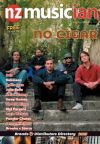More Than A Mailing List: The Potential of Substack for Kiwi Artists
More Than A Mailing List: The Potential of Substack for Kiwi Artists
Dave Johnston is a music producer, mixing engineer, musician and educator. As the artist-producer behind n1ghtmar3cat he has adopted Substack as the online home for his n1ghtmar3cat Music Factory creative communications, a platform for taking a deep-dive information sharing approach to experiencing and experimenting with aspects of songwriting and music production. More than a mailing list, n1ghtmar3cat sees plenty of potential in Substack for Kiwi artists to explore.
In today’s music scene artists aren’t just musicians; we also need to be entrepreneurs, marketers, and content creators all rolled into one. For some of us, becoming our own marketing department is a daunting and uncomfortable job as we try to figure out (often haphazardly) how to interact with people on various social media platforms, create an adequately appealing website, develop an effective press kit, and broadly learn how the music industry works so we can attract people to our work.
Many newcomers hope that getting signed will alleviate these burdens, but in reality, labels seek out artists who are already excelling at these tasks so that they can amplify the good work that’s happening, not create the buzz from scratch. So, there’s no escaping it – we have to learn how to build our online brand ourselves. All this, of course, is balanced alongside the main thing we wanted to do in the first place: make music.
Even with my experience in the industry with Villainy, Delivery Boyz, and working with other artists, it’s taken me a long time to figure out how to interact authentically online for my solo project, n1ghtmar3cat. The n1ghtmar3cat persona doesn’t fit with the latest TikTok trends, and I’m not someone who wants to constantly share my daily life just to boost numbers. How do I find my audience and build a genuine online presence that they would find valuable?
So, for 2025, I decided to try something new. Instead of creating content based on the social media parameters of the day I’d write longer-form pieces, sharing my creative process and thoughts about making music as n1ghtmar3cat, including ideas and works-in-progress, and I’d commit to publishing regularly. Hopefully, by sticking at it, I’d build a following of people looking to dive deeper into songwriting, music production, and creativity. So, I needed a platform suited to my new approach of prioritising depth over algorithms.
 Enter Substack – the new home for what I’ve called n1ghtmar3cat Music Factory.
Enter Substack – the new home for what I’ve called n1ghtmar3cat Music Factory.
In essence Substack is a platform that empowers writers and creators to publish and share subscription-based newsletters directly with their audience. It offers interactive elements such as comments and chat features and has tools to manage subscriptions and monetise certain content if you choose to. It’s all about fostering a direct connection between creators and their readers, with greater control over the narrative and presentation.
There are some similarities to the classic artist mailing list, but Substack also gives the content an accessible online home, offers modern communication features between author and audience, and the ability to publish video and podcast content. While I’ve only posted written content so far, embedding audio and links where needed, I have no doubt I’ll explore these additional features as I grow the project.
I post an article every second week, exploring the ins and outs of songwriting, music production, and creativity through the lens of my songwriting and production work as n1ghtmar3cat. Articles might break down a song I’ve released, discuss the software and plugins I use, talk about my writing process, share demos or ideas I’ve been working on, or give readers production tips based on things that have worked for me. While it’s still early days (I’ve only been publishing since the start of the year), I already feel like it’s a medium that will allow me to share my work in ways that fit with my project as it grows, and it excites me to know I can take it in any direction I want.
To give a clearer picture of what this looks like in practice, here are some examples of recent n1ghtmar3cat Music Factory articles and their descriptions:
Beyond the Likes: Why Process Beats Outcome in Music Production
I discussed the benefits of focusing more on the creative process and the things we control rather than seeking external validation and paying too much attention to the things we can’t control.
Reimagining a Classic: My Journey with Your Song
In this article, I broke down a single I’ve recently released (my rendition of Your Song, the Elton John classic from 1970) and discussed how I tried to create a unique-sounding cover version.
The Power of Vocal Manipulation: How I Use My Voice as an Instrument
I use vocal recordings in a whole bunch of interesting ways in my music production to give songs a unique flavour associated with the singer, which I discussed with some examples from previous releases in this article.
Currently, this seems like a relatively untapped resource; as far as I can tell, few Kiwi musicians are using Substack, but I think that will change. There’s an opportunity to create a unique space for fans to interact with your work at a deeper level beyond listening to your music or following your social media channels, all without being bombarded by ads. Content that brings fans into the inner workings of your project could include deep dives about your songs, AMA sessions, writing about touring adventures, sharing demos or work-in-progress recordings. It’s really up to you and the type of community you want to create.
Such an online space will attract your biggest fans and invite them to learn more about you, increasing the chances they’ll buy merch, vinyl, tickets to shows, and share your work with others – all things that will help to sustain your career. The ability to monetise some of your Substack content means that these fans may eventually pay you to keep creating the content directly.
While musician Substacks aren’t all that common just yet there are some useful examples of what we might aim for. Kimbra is the best example I’ve found of a Kiwi artist creating something valuable for her fans on Substack. She shares short-form and long-form writing about her creative journey, artworks, poems, interviews, and she uses a range of different media types to do so. Because she’s been doing it for several years there’s a wealth of archival content for fans to dig through and explore.
A couple of offshore examples of musicians building communities on Substack include Colin Meloy (The Decemberists) with his Substack Colin Meloy’s Machine Shop, Patti Smith’s self-titled Substack, Jeff Tweedy’s (Wilco) Starship Casual, and Billy Corgan’s (The Smashing Pumpkins) Orange Fades to Gray.
So, if like me, you’re looking for a place online that will allow you to authentically write about and share your work for fans wanting a bit more than the odd reel or update, perhaps give Substack a go. If you do start publishing, connect with me at n1ghtmar3cat.substack.com so I can check out your approach. Let’s build up a new community of Kiwi musicians on Substack and support each other’s work.
Dave Johnston (@n1ghtmar3cat) is a music producer, mixing engineer, and musician. He’s the artist-producer behind n1ghtmar3cat, the drummer in Villainy, and the singer and music producer in Delivery Boyz. Dave is also a lecturer and the Industry Liaison at SAE Creative Media Institute in Auckland.

